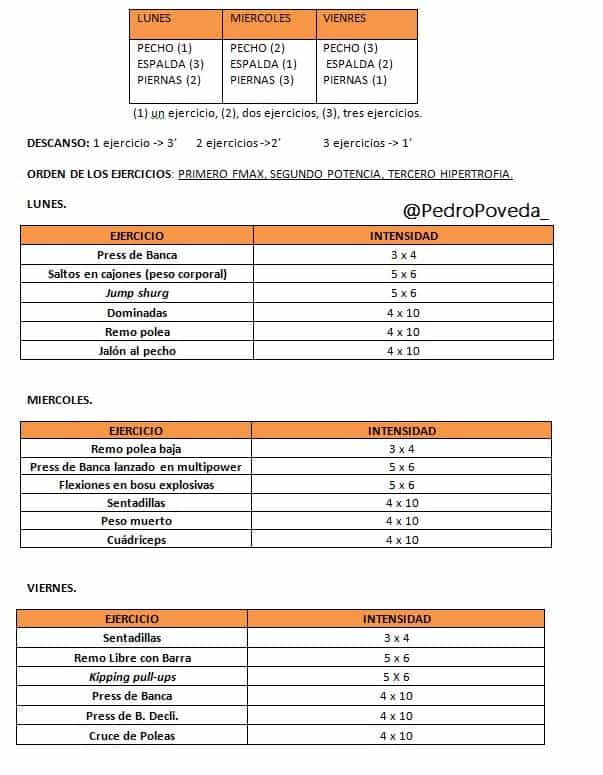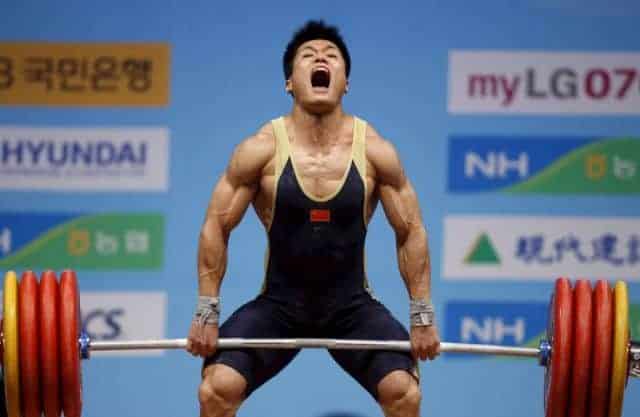The strength training against resistance is nowadays one of the most used training methods by athletes and the general population.
Undulating periodization training is attributed to a series of adaptations, stemming from the stimulus received by the skeletal muscle, such as the hormonal response and increase of hormones like growth hormone (GH) and testosterone, the increase of satellite cells, increase in muscle fiber thickness (hypertrophy), or improvement in protein synthesis among others (1).
This type of training has been shown that, if controlled in a periodized manner (control and progress of the volume and intensity of the loads), we find improvements compared to constant methods (2).
This undulating periodization has traditionally been linear, achieving training objectives through clearly differentiated mesocycles (example: hypertrophy mesocycle, maximum strength mesocycle), following a progression or increase in load.
Undulating periodization, innovation in training
However, nowadays, new planning models have emerged for this type of strength training, such as undulating periodization, which is the one that instead of increasing or decreasing the volume or intensity monthly, does it weekly and even daily, and modifies the orientation of the training, not focusing only on one manifestation such as maximum strength, hypertrophy, or power, but seeking to develop all capacities at the same time (3).
Some of the advantages that this training method allows have been described by numerous authors in research comparing linear and undulating periodizations (4-7), but are summarized in (8):
- Allows for greater variety in exercise sequences.
- Allows athletes to catch up more quickly in an exercise sequence after having suffered an illness or injury.
- Causes less monotony in daily exercise routines.
- Can adapt to the various situations of a specific training day and offers athletes the most effective type of exercise.
- Allows for more frequent rest of some muscle tissues thanks to the use of various resistance loads.
Therefore, nowadays , numerous sports that hold competitions weekly or in short periods of time, cannot focus on the development of a capacity in a linear manner, as it prevents the development of another until the different mesocycles are completed, undulating periodization is a proven method that allows us to develop and work all capacities together.
Methodological proposal
This training is designed for subjects trained in strength since the intensity required is maximum and we must be fully adapted to training in all its orientations. To be able to perform power training, hypertrophy is needed to strengthen joints and tendons to avoid possible injuries since movements are at the maximum possible speed. Therefore, this training is not oriented for beginners or untrained individuals.
The training will be undulating in both volume and intensity. This type of training is characterized by training the different manifestations of strength on different days of the week, to fully develop all capacities without focusing on just one. It will be performed on three days separated by 24-48 hours.
3 global exercises will be selected for each of the main muscle groups (chest, back, and legs). Each day, the three muscle groups will be worked on, but the number (3, 2, or 1) and type of exercise (oriented to strength or power) as well as the intensity of each (selected load, repetitions, and rest time) will vary.
Number of exercises
- Power: 2 exercises.
- Strength: 1 exercise.
- Hypertrophy: 3 exercises.
Training days
- Day A: Chest (Power), Back (Strength), and Legs (Hypertrophy).
- Day B: Chest (Hypertrophy), Back (Power), and Legs (Strength).
- Day C: Chest (Strength), Back (Hypertrophy), and Legs (Power).
Intensity and volume of training
- Power: 3-5 sets x 5-6 repetitions (Loads between 30-40% of 1RM at the maximum possible speed).
- Strength: 3-4 x 3RM.
- Hypertrophy: 4 x 10 RM.

Training orientations
The training, although oriented towards the improvement of the different manifestations of strength, can be oriented depending on the time of the season or if we need to focus our training on the development of one capacity over another.
In phases close to competition, if in our sport, for example, power is a determining factor in our sports gesture, we could replace hypertrophy exercises with new power exercises or exercises more oriented to plyometrics in case we need power in the lower body.
Also, if in our sport we require endurance, both aerobic and anaerobic (soccer, basketball, handball, etc.), we could replace a training day, or add to our week some type of concurrent training (strength + endurance) oriented towards the improvement of power (Power-HIIT) or strength.
Bibliography
- Hawke, T. (2005). Muscle stem cells and exercise training. Exercise Sport Science. 33, 63-68.
- Fleck, S. and Kraemer W. (2004). Designing resistance training programs. 3rd ed. Champaign, IL: Human Kinetics.
- Brown, L. (2008). Strength training. Editorial médica panamericana. 1st ed.
- Kraemer, W. (1997). A series of studies: the physiological basis for strength training in American football: fact over philosophy. Journal of strength and conditioning research. 11, 131-142.
- Kraemer et al. (2000). Influence of resistance training volume and periodization on physiological and performance adaptations in collegiate women tennis players. American Journal of Sports Medicine. 28, 626-633.
- Kraemer et al. (2003). Physiological changes with periodized resistance training in women tennis players. Medicine and Science in Sports and Exercise. 35, 157-168.
- Marx et al. (2001). Low-volume circuit versus high volume periodized resistance training in women. Medicine and Science in Sports and Exercise. 33, 635-643.
- Kraemer W., and Fleck, S. (2007). How to optimize strength training. Champaign, IL: Human Kinetics.

